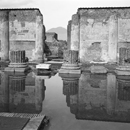Wesleyan University's Ezra and Cecile Zilkha Gallery presents "Urban Space, Roman Couture, and A Living Past: Views of Pompeii and Pantheon - Marc Erwin Babej and William Wylie" September 10 through October 6, 2019

Marc Erwin Babej
Marc Erwin Babej, "Mars, apud templum Romanum Martis Ultoris," 2016. Archival digital pigment print. 30 x 40 inches. Courtesy of the artist.
Click here to download high resolution version.
Marc Erwin Babej, "Mars, apud templum Romanum Martis Ultoris," 2016. Archival digital pigment print. 30 x 40 inches. Courtesy of the artist.
Click here to download high resolution version.

William Wylie
William Wylie, "Basilica (VIII. 1), Pompeii," 2013. Archival pigment print. 37 x 45 inches. Courtesy of the artist.
Click here to download high resolution version.
William Wylie, "Basilica (VIII. 1), Pompeii," 2013. Archival pigment print. 37 x 45 inches. Courtesy of the artist.
Click here to download high resolution version.
There will be an artist talk with Marc Erwin Babej and William Wylie on Thursday, September 19, 2019 at 4:30pm in Ring Family Performing Arts Hall, located at 287 Washington Terrace. Admission to the presentation and conversation is free. The two artists will come together to discuss their works, both of which speak to im/permanence, the changing of cultural narratives, and the power of Rome in modern imagination. A reception will follow in the South Gallery of the Ezra and Cecile Zilkha Gallery with refreshments.
Co-sponsored by the Classical Studies Department, Samuel Silipo ’85 Distinguished Visitors Fund of the Department of Art and Art History, Fries Center for Global Studies, College of Letters, History Department, Department of Romance Languages and Literatures and the Thomas and Catharine McMahon Fund.
About the Artists
Artist William Wylie’s subject is Pompeii. The once-flourishing city on the Bay of Naples was destroyed during the eruption of Mount Vesuvius in 79 CE, and it has long been renowned for its vivid evocation of ordinary life and sudden catastrophe. Wylie’s images are meticulously composed, finely observed black-and-white studies, primarily of architecture. Even though Pompeii is normally thronged with tourists, his pictures of the buildings are unpopulated and still, allowing us to attend to the details of the structures that remain. The photographs are documentary, in that they represent real scenes in real time, and they are also unmistakably the products of an artist's sophisticated eye and sensibility. His photographs of the ruins capture the shadow of a fallen empire.
Rather than a Rome in ruins, artist Marc Erwin Babej envisions a Rome that never fell. His "Pantheon" may be categorized less as photography and more as "photo-based art." Created with a camera and a computer, his pictures commingle the genres of portraiture and fashion and dramatic tableau. They are infused with Roman myth and history, to which Babej brings a scholar's knowledge and a devotee's enthusiasm. Each of the solitary figures bears a name that is well-known from Roman antiquity; each is set in a digital reconstruction of an identifiable building that stands, or once stood, in or near the city itself. The resulting images are elegant, engaging visual fictions that allude to the rich diversity of the Roman world. His digital images imagine a Roman couture for the present day.
Although the two bodies of work are very different, both of them are creative, sophisticated responses to "the grandeur that was Rome."